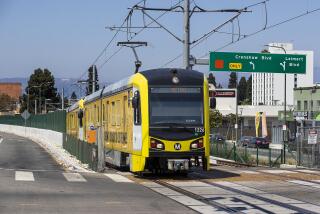Tunnel visions
MEGA-TUNNELS FOR FREEWAYS are an idea whose time hasn’t come for Southern California. They’re expensive, often environmentally dubious (especially in a region crisscrossed by fault lines) and frequently proposed for routes better served by surface roads or expanded public transportation. But there is an exception: twin tunnels under South Pasadena that, if built, would be among the largest in the world.
The Metropolitan Transportation Authority on Tuesday unveiled a preliminary study of the costs, environmental effects and possible funding of the 4 1/2-mile tunnels, which would finally connect the Long Beach Freeway in Alhambra with the Foothill Freeway in Pasadena. In essence, it said the project was feasible in every way -- even financially. Though it would cost about $3 billion, up to half the money could be raised by turning the tunnels into toll routes.
The plan is more practical than two other tunnel schemes being proposed in Southern California -- an expensive, 23-mile complex of mega-tunnels and surface routes between Palmdale and Glendale, and a geologically disastrous 12-mile tunnel under the Cleveland National Forest to connect Riverside County with the Laguna Freeway in Orange County.
It’s also probably the only way to solve a serious traffic problem. Planners have been trying for 50 years to extend the 710 Freeway to Pasadena, only to hit fierce opposition from homeowners along the route. The result is gridlock through downtown L.A. and increased air pollution.
As officials continue to study the tunnel plan, they also should consider unknotting a public-policy tangle. During the half a century that transit officials have been planning the 710 extension, the state has been buying houses along the proposed route. The tunnels would save those houses from demolition, yet under a 1979 state law, they have to be sold under a formula that gives first priority to existing tenants and assures that most of them will be sold to low-income buyers at far below market rate. As a result, the 573 properties, which would fetch about $500 million at market rate, are expected to go for only about a tenth as much.
The law attempts to use a highway project to help solve a housing problem, which probably wasn’t the best idea in the first place. At any rate, the Legislature probably didn’t intend to subsidize the purchase of million-dollar homes. A new law that would exempt this project from the affordable-housing rules and assure that proceeds from the home sales would go toward building the tunnels would be the most direct and sensible way to benefit taxpayers.
More to Read
Sign up for Essential California
The most important California stories and recommendations in your inbox every morning.
You may occasionally receive promotional content from the Los Angeles Times.










